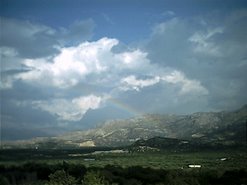Σλαβομακεδόνικα.
Τέλη της δεκαετίας του ’70, μια και ήξερα
ρώσικα αποφάσισα να ασχοληθώ και με τις άλλες σλάβικες γλώσσες. Όταν ξέρεις μία
της οικογένειας, τις άλλες τις μαθαίνεις εύκολα. Για παράδειγμα, ξέροντας
γαλλικά (επάρκεια), έμαθα αρκετά εύκολα ιταλικά, ισπανικά και πορτογαλικά. Έτσι
ασχολήθηκα με τα βουλγαρικά, τα σερβοκροάτικα και τελευταία τα τσέχικα, σε
επίπεδο μεθόδου άνευ διδασκάλου. Θυμάμαι
που συνάντησα στον Παχύ Άμμο ένα τσέχο και τον έβαλα και μου διάβασε τα κείμενα
του teach
yourself books και τα ηχογράφησα. Μόνο με τα πολωνικά δεν ασχολήθηκα γιατί δεν
είχα δείγματα προφοράς. Όταν βλέπω όμως πολωνική ταινία αναγνωρίζω πάρα πολλές λέξεις
από τα ρώσικα.
Αργότερα αυτές τις γλώσσες τις εγκατέλειψα. Δεν
μπορούσα να κυνηγάω δυο λαγούς, όπως έλεγε ο πατέρας μου. Έτσι περιορίστηκα μόνο
στη βελτίωση των ρωσικών μου. Τώρα που έχει γίνει επίκαιρο το μακεδονικό,
αποφάσισα να ρίξω μια ματιά στη γλώσσα των Σκοπίων, όχι για να εμβαθύνω, αλλά
σε επίπεδο μεθόδου άνευ διδασκάλου, όπως και με τις άλλες. Εδώ βρήκα ένα κείμενο
και αποφάσισα να αναρτήσω τις έξι πρώτες σελίδες του, γιατί οι υπόλοιπες
πενήντα πέντε είναι καθαρά γλωσσολογικές.
0
Sociolinguistic and Geolinguistic Situation
0.1 Geography
Macedonia
has been the name of a Balkan region since ancient times, when it was bounded
by
Epirus,
Thessaly, and Thrace on the southwest, south, and east. At present geographic
Macedonia
is best
defined as the region bounded by a series of mountains and ranges (Olympus,
Pindus, S‹ar,
Rhodopes)
and the lower course of the river Mesta (Greek: Néstos). It comprises the
Republic of
Macedonia,
the Blagoevgrad District in southwestern Bulgaria (Pirin Macedonia), and the
district
of
Makedhonía in the province of Northern Greece (Aegean Macedonia). Two small
parts of
eastern
Albania — one around Lakes Ohrid and Prespa and the other around Golo Brdo
(Albanian:
Golobordë)
— can also be included in a geographic definition of Macedonia (cf. Vidoeski in
Koneski
1983:117).
0.2 Terminology
and History
The
geographic region, like the rest of the Balkans, has always been multilingual.
For our
purposes,
Modern Macedonian (henceforth, Macedonian) can be defined as the Slavic
dialects
spoken on
the territory of geographic Macedonia.1 Macedonian is a South Slavic language
in the
Indo-European
language family. Together with Bulgarian, Macedonian comprises the East South
Slavic
sub-group. The West South Slavic languages are Slovenian and the former Serbo-
Croatian.2
Ancient
Macedonian, an independent Indo-European language of uncertain affiliation, was
spoken
in at
least part of Macedonia in the fifth and fourth centuries B.C. and presumably
both earlier and
later.
This gave way to Greek, which was in turn supplanted by Slavic when the Slavs
invaded
and
settled in the Balkans in the sixth and seventh centuries A.D. The Ottoman
conquest of the
Balkan
peninsula in the fourteenth and fifteenth centuries brought about a disruption
of cultural
continuity
with regard to Slavic literacy in that region. The history of Modern Literary
(or
Standard,
for the purposes of this exposition, the two terms are synonymous) Macedonian
begins
in the
latter part of the eighteenth century with the birth of South Slavic
nationalism. Until about
1840,
publications using Macedonian dialects were ecclesiastical and didactic works
that were
influenced
by Church Slavonic but had clearly identifiable colloquial bases. The goal was
to
establish
a vernacular-based Slavic literary language in opposition to both the
archaizing influence
of those
who would have imposed some form of Church Slavonic and the Hellenizing
attempts of
the Greek
Orthodox Church, to which the majority of Macedonians and Bulgarians belonged.
The
authors of
this period on the Ottoman territory that later became Macedonia and Bulgaria
called
their
vernacular language Bulgarian. By the mid-nineteenth century, a struggle
over the dialectal
base of
the emerging vernacular literary language became manifest. Two principal
literary centres
1 The
dialects of the Slavic-speaking Muslims of the Gora region on the eastern and
northern slopes of Mts.
Korab and
S‹ar in Albania and Kosovo are also classed as Macedonian by Vidoeski (1986), a
view that i s
implicitly
accepted by the Croatian and Serbian linguists Brozovic! and Ivic! (1988:70-71).
Other languages
spoken on
the territory of geographic Macedonia include Albanian, Aromanian, Bulgarian,
Greek, Megleno-
Romanian,
Romani, Serbian, and Turkish. Until the Holocaust, Judezmo was also an
important language in
Macedonia,
and it is still spoken by some survivors.
2 The West
South Slavic dialects adjacent to Macedonian are all Serbian, and the variant
of the former
Serbo–Croatian
standard of the former Yugoslavia that had the most influence in Macedonia was
the Serbian
variant.
Thus, in this work I use the term Serbian, depending on the context, to
refer to the Serbian variant of
the former
Serbo–Croatian, the current standard of the Federal Republic of Yugoslavia, or
to the Serbian
dialects.
The term Serbo–Croatian is used to refer to the standard language of
former Yugoslavia as such.
LW/M 117 5
MACEDONIAN
arose: One
in northeastern Bulgaria and the other in southwestern Macedonia. Macedonian
intellectuals
envisioned a Bulgarian literary language based on Macedonian dialects or a
Macedo-
Bulgarian
dialectal compromise. Bulgarians, however, insisted that their Eastern standard
be
adopted
without compromise. This period was marked by considerable struggles and
polemics
over the
publication and use of textbooks with Macedonian dialectal bases.
The
establishment of an independent Bulgarian Church (the Exarchate) in 1870-72
marked a
definitive
victory over Hellenism. It is from this period that we have the first published
statements
insisting
on Macedonian as a language separate from both Serbian and Bulgarian (Pulevski
1875:48-49),
although these ideas were expressed during the preceding period in private
correspondence
and similar documentation. In his book Za makedonckite raboti ‘On
Macedonian
matters’
(Sofia, 1903), Krste Misirkov outlined the principles of a Macedonian literary
language
based on
the Prilep-Bitola dialect group, i.e. precisely the dialects which later served
as the basis
of
Literary Macedonian. This work documents the coherent formulation of a
Macedonian literary
language
and nationality from the beginning of the twentieth century, thus belying the
claim that
Macedonian
separateness dates only from the end of World War Two.
On 18
October 1912 the Kingdoms of Bulgaria, Greece, and Serbia united against Turkey
in the
First
Balkan War. Less than a year later Macedonia was partitioned among these three
allies,
essentially
marking the end of the development of Literary Macedonian outside the borders
of
Yugoslavia
except for the period 1946-1948, during which the Macedonians of Pirin
Macedonia
were
recognized as a national minority in Bulgaria with their own schools and
publications in
Literary
Macedonian. In accordance with article 9 of the Treaty of Sèvres (10 August
1920)
concerning
minority population language rights in Greece, a commission of three men,
probably
from
Bitola and of Aromanian origin, composed a Macedonian primer entitled Abecedar
printed in
Athens in
1925 using a Latin orthography and based on dialects spoken between Bitola and
Lerin
(Greek
Florina). The book was never used, however, and most copies were destroyed. In
Yugoslavia,
Macedonian was treated as a South Serbian dialect, which was consistent with
claims
that had
been advanced since the nineteenth century, but the Yugoslav government
permitted
Macedonian
literature to develop on a limited basis as a dialect literature. Some
Macedonian
poetry was
also published in Bulgaria under the guise of (Bulgarian) dialect literature.
It was
during
this interwar period that linguists from outside the Balkans published studies
in which they
emphasized
the distinctness of Macedonian from both Serbo-Croatian and Bulgarian (Vaillant
1938).
0.3 Standardization
Although
efforts at the creation of a Macedonian literary language date from the
nineteenth century,
it was not
until 2 August 1944 that Macedonian was formally declared the official language
of the
Republic
of Macedonia. The standardization of Literary Macedonian proceeded rapidly
after its
official
recognition, in part because an inter-dialectal koine was already functioning.
The West
Central
dialect (Bitola-Veles-Prilep-Kic#evo), which was the largest in both area and
population,
supplied a
base to which speakers from other areas could adjust their speech most easily.
In many
respects
these dialects are also maximally differentiated from both Serbian and
Bulgarian, but
differentiation
was not an absolute principle in codification. A significant sociolinguisitc
issue
now, for
Literary Macedonian, is the fact that Skopje — the capital and principal
cultural and
LW/M 117 6
MACEDONIAN
population
centre — is peripheral to the West Central dialect area and the Republic as a
whole has
been
subject to considerable Serbian influence (see Minova-G⁄urkova 1987). For more
details see
Friedman
(1985, 1998, 2000), and Lunt (1984, 1986).
0.4 Status
Literary
Macedonian is the official language of the Republic of Macedonia. It was
recognized as
such by
all countries except Bulgaria — where it was an official minority language
1946-48 and
subsequently
officially viewed as a “regional norm” or "dialect" of Bulgarian —
and Greece,
where
Macedonian is usually claimed not to exist — except in proclamations banning
its use — or
it is
claimed that the term Macedonian can only be used to refer to the Greek
dialects of Macedonia
or to
Ancient Macedonian (see Human Rights Watch/Helsinki 1994). In 1999, the
Bulgarian
government
officially recognized the standard language of the Republic of Macedonia as an
independent
language, but did not recognize the dialects spoken outside the Republic as
part of that
language.
Nonetheless, there are citizens of and emigrants from both Bulgaria and Greece
who
identify
their native (Slavic) language as Macedonian. It is also spoken in about 50 to
75 villages in
eastern
Albania and Southwestern Kosovo, where it is used as a language of instruction
in
elementary
schools up through grade 4 only in the southwestern villages of the
Ohrid-Prespa
region.
The relationship of Macedonian to Bulgarian is mutatis mutandis,
comparable to that of
Dutch to
German. The main difference is that no serious modern scholar, nor even
journalistic
authors,
would describe Dutch as a codified German dialect, whereas such misstatements
of the
relationship
of Macedonian to Bulgarian continue to appear. See Haugen (1968) for relevant
comparative
material on the Scandinavian languages.
0.5 Dialects
The map
shows the location of the thirty pre-1996 municipal centers of the Republic of
Macedonia
as well as
rivers and regions of dialectological significance.3 Locations outside the
Republic of
Macedonia
of significance for Macedonian dialectology are also indicated. Names in
parentheses in
Greece and
Albania are in Greek and Albanian, respectively. In Bulgaria, the pre-1950
names are
given in
parentheses. The names of the major dialect groups are given below the map. The
towns
given in
parentheses are included in the given group.
0.5.1 Major
Isoglosses
The major
East-West bundle of isoglosses runs roughly from Skopska Crna Gora along the
rivers
Vardar and
Crna, east of Lerin (Greek Florina) and then bifurcates south of Lerin
separating the
Korc#a-Kostur
(Albanian Korçë, Greek Kastoria) dialects into a separate group (see Vidoeski
in
Koneski
1983). A significant North-South bundle separates the Lower Polog and
Kratovo-Kriva
Palanka
dialects from the rest. Skopje is located roughly at the intersection of these
two main
bundles of isoglosses.








No comments:
Post a Comment